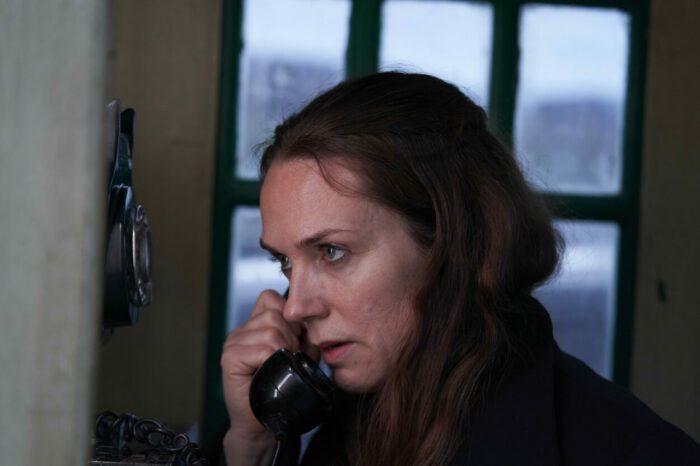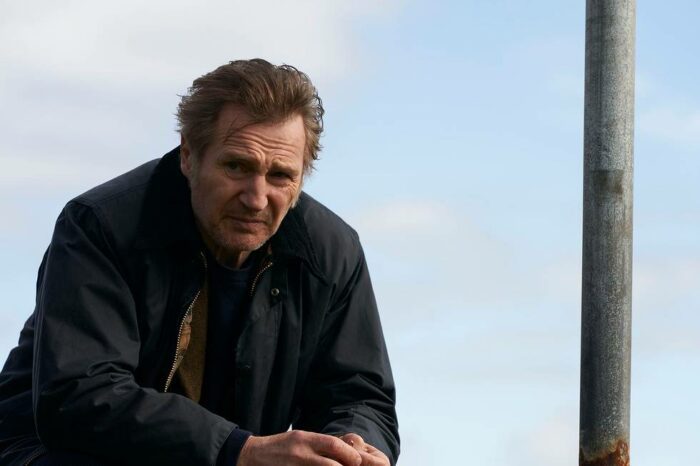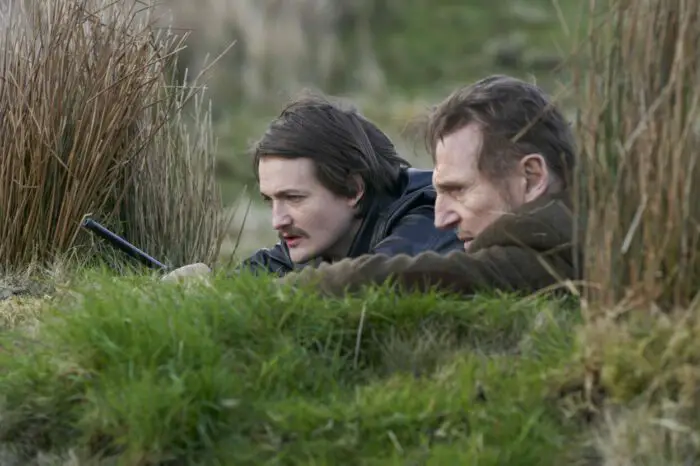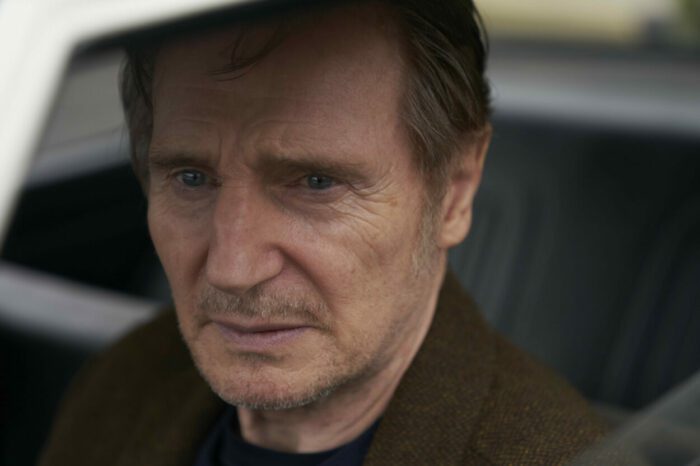This isn’t meant to sound like a cheeky pub joke, but maybe it works that way too. What should we call an Irish western? Are they like the Italian ones where the name needs to include a loosely ethnic food descriptor like spaghetti? Does that mean Irish westerns are potato westerns? Cabbage westerns, maybe? Do we just chug a pint and call them Guinness or stout westerns? We might be at a loss naming this subcategory for In the Land of Saints and Sinners, but the parallel metaphors, conceits, and tropes of a transported western are all there.
The setting of In the Land of Saints and Sinners opens in Belfast in 1974. A short title card sends up the informative flare that the island is knee-deep in The Troubles period of violent civil unrest. The opening scene is a pub bombing gone wrong by terrorist Doireann McCann (The Banshees of Inisherin Oscar nominee Kerry Condon) where the collateral damage included the deaths of a few passerby school children. With more blood on their hands than what was ordered, Doireen and her associates flee west (see, here we go) from Northern Ireland in the United Kingdom to Donegal, Ireland’s northernmost county Donegal.

The McCann crew descends upon the coastal village of Glencolmcille and squats in the utility buildings of Sinead (Sarah Greene of The Guard and Burnt), a local bartender and in-law of Doireann’s brother Curtis (The Last Rifleman’s Desmond Eastwood). They’re laying low while building their next pipebomb and plotting its target. However, they are not the only violent and tough element present in this cuddly hamlet.
Glencolmcille is also the home of the veteran assassin and proficient pipe smoker Finbar Murphy (the toplining Liam Neeson). After a career of burying his marks underneath replanted conifers next to a lush creek, he is calling it quits as a hired gun and cashing out with his superior Robert McQue (fellow Irish treasure Colm Meaney) in favor of a quiet retirement. Finbar insists McQue pass his jobs to Kevin (Jack Gleeson, all grown up from Game of Thrones), the mop-topped young sharpshooter waiting in the wings.

Contentedly hanging up his weapon of choice—a smooth bore Holland & Holland double-barreled rifle matching the classic favored by Teddy Roosevelt and evoking the whole western feel further (come on, that’s a pure cowboy’s gun for the 1970s), Finbar settles down in the town with where he knows everyone and everyone knows him as merely a book dealer. He renews his friendship with the lone local cop Vinnie O’Shea (Belfast Oscar nominee Ciarán Hinds) and finds himself sweet on his gardening neighbor Rita (Niamh Cusack of Hereafter). Retirement lasts all of a few days until Finbar gets wind of the visiting Curtis abusing Sinead’s daughter Moya (Michelle Gleeson). The good he seeks to do now as a protector means that old rifle has to come down off the trophy shelf.
The second act build-up of In the Land of Saints and Sinners takes its time. Director Robert Lorenz, who worked with Neeson on 2021’s The Marksman and is a former apprentice to Clint Eastwood’s grizzled minimalism, emphasizes a path of emotional reflection for the reformed protagonist as earmarked in the script from Mark Michael McNally and Terry Loane. Finbar semi-scolds Kevin to relay that every execution he enacted was unpretty and serious. Kevin doesn’t get that, leading to voiced proverbs of “Indulgence draws the weak to an early grave” and “My advice is more valuable than money, son.” Much of this is Neeson doing his best to be the worldly actor he started as more than the stock tortured soul persona he’s leaned on for the past decade-plus.

After that middle stretch of In the Land of Saints and Sinners steeps like tea, an escalation of threatened safety leads to—what else—a requisite shootout finale, shot by director of photography Tom Stern (The Last Voyage of the Demeter). Leaning on both the western and the Irish tropes, the climactic showdown starts with errant bullets shattering glasses and wounding bystanders enjoying the fiddle music at the local pub and ends at a picturesque candlelit old church. This is supposed to be the peak of tension where gradually increasing losses and deaths should matter. Instead, the suspense is fleeting and our noses hurt from being struck so hard by the western emulation. If that wasn’t enough, the naturalistic score by the Great Garbo Baldenweg siblings, featured blues harp work by their father Pfuri Baldenweg, lays that tone on even thicker all movie long.
Outside of the headlining Liam Neeson given full breadth to wax poetically and unfurl any and all character shadings he wants, In the Land of Saints and Sinners curtails the rest of the cast’s talent and high potential. Robert Lorenz had two recent Academy Award nominees in Kerry Condon and Ciarán Hinds. While it’s a boon for a woman to have the top villain spot opposite Neeson, Condon’s character is all cursing snarl with weak and remote conviction for the roots of The Troubles. Hinds, at the drop of any hat– woolen or otherwise, has gravitas for days, and the film leaves him as the doddering cop and the honest old buddy. Catching an older and still rising Jack Gleeson should have meant more than having him play the stereotypical hothead youth who ignores all the elders. Even the ever-reliable character actor Colm Meaney can do more than play a one-note handler.

All of those recognizable ensemble members, as well as plenty of the lesser-known folks under them, should have been able to contribute thicker substance. The missed opportunity starts with the film’s time period. Even with Dioreann’s rants and raves as the bomber, too much of In the Land of Saints and Sinners sidestepped or entirely ignored The Troubles. The spine of history was right there for heftier commentary, complete with a very capable cast to deliver it. Instead, the volatile strife which gripped the split country for so long is only a out-of-town newspaper headline and a mentioned separator trait between black hats and even blacker hats.
Be that as it may, In the Land of Saints and Sinners earns a fair victory by slowing down and softening Liam Neeson from his signature gear of constant action ferocity. Even while playing a contract killer with imposing intimidation in his back pocket, the soon-to-be 72-year-old was granted a warmer character who exudes thoughtful wisdom first and brutality second. Clearly, the chance to give a little more of his best back to audiences on his home turf was irresistible and appreciated by Neeson.
Speaking of sods and grasses, we’ve circled back to the opening conundrum. Let’s be the ones to coin the new and Urban Dictionary-worthy term (officially submitted after this) for an Irish western. Triumphantly, the versatility logic of Samwise Gamgee puts starchy potatoes over the top of cabbage and possible trademark infringement with Guinness for their roasted malted barley. Therefore, with the proper capital lettering to add importance, In the Land of Saints and Sinners gives you… the Potato Western! Hopefully, all the ways potatoes can be prepared will echo the variety possible for future movies of the subgenre because this was blandly boiled no matter which source food was granted the naming rights.




